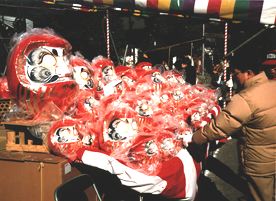ANNUAL CALENDAR January |
|
Daruma fair
|
 On January 6 and 7 each year, a temple in Takasaki, Gunma Prefecture, hosts a fair of daruma dolls. These dolls are bright red likenesses of Bodhidharma, an Indian monk who founded Zen Buddhism in the sixth century. Legend has it that the monk sat meditating in a cave for so long (nine years!) that he lost the use of his legs.
On January 6 and 7 each year, a temple in Takasaki, Gunma Prefecture, hosts a fair of daruma dolls. These dolls are bright red likenesses of Bodhidharma, an Indian monk who founded Zen Buddhism in the sixth century. Legend has it that the monk sat meditating in a cave for so long (nine years!) that he lost the use of his legs.
This is why the daruma doesn't have any limbs. It's a roly-poly doll that returns to an upright position when tipped over. It's also a good luck charm that helps people fulfill their wishes; it encourages us to keep working toward our own goals even when others are trying to knock us over. Daruma fairs are held throughout Japan at the beginning of the year. The biggest and most famous of these is the one at Darumadera, a temple in Takasaki about 100 kilometers (62 miles) northwest of Tokyo. This fair began around 200 years ago, when the head priest, concerned about local villagers who were going hungry because of a crop failure, taught them how to make these dolls and allowed them to set up shops at the temple during a New Year festival. Today, the two-day fair features around 110 daruma-selling stalls on the temple grounds. They sell around 20,000 dolls each year to the more than 300,000 visitors who come to the fair. A new doll doesn't have its eyes painted in yet; this is because the purchaser draws in one eye while making a wish, and draws in the other when the wish is fulfilled. Large daruma with just one eye drawn in are always found in the offices of politicians at election time. No, the dolls aren't trying to win over voters by winking; the second eye gets painted in when the candidate is successfully elected!
Photo: The daruma dolls are sold in many different sizes. (Kyodo) |
For more about the daruma, visit the Takasaki daruma page in JIN Japan Altas. |
APR | MAY | JUN | JUL | AUG | SEP | OCT | NOV | DEC | JAN | FEB | MAR |
 |